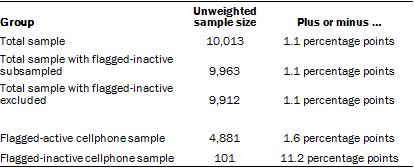The analysis in this report is based on telephone interviews conducted Jan. 23-March 16, 2014, among a randomly selected national sample of 10,013 adults, ages 18 and older, living in all 50 U.S. states and the District of Columbia (5,010 respondents were interviewed on a landline, and 5,003 were interviewed on a cellphone, including 2,649 who had no landline telephone). The survey was conducted under the direction of Abt SRBI. A combination of landline and cellphone random-digit-dial samples were used; both samples were provided by Survey Sampling International. Interviews were conducted in English and Spanish. Respondents in the landline sample were selected by randomly asking for the youngest adult male or female who was at home at the time of the call. Interviews in the cell sample were conducted with the person who answered the phone, if that person was an adult 18 years of age or older. All cellphone numbers were manually dialed. For detailed information about our survey methodology, see https://www.pewresearch.org/methodology/u-s-survey-research/.
Data collection was divided equally into three phases (A, B, and C) with independent samples, non-overlapping interview dates and separate weighting. The questionnaire for each phase contained a core set of measures of political attitudes and values, political engagement and demographic characteristics, along with a set of unique questions about issues, lifestyle, media use and other topics covered in this series of reports. Additionally, most respondents to the survey were invited to join Pew Research Center’s American Trends Panel.
The combined landline and cellphone sample is weighted using an iterative technique that matches gender, age, education, race, Hispanic origin and nativity and region to parameters from the 2012 Census Bureau’s American Community Survey and population density to parameters from the 2010 U.S. Census. The sample also is weighted to match current patterns of telephone status (landline only, cellphone only, or both landline and cellphone), based on extrapolations from the 2013 National Health Interview Survey. The weighting procedure accounts for the fact that respondents with both landline and cellphones have a greater probability of being included in the combined sample and adjusts for household size among respondents with a landline phone. Three sets of weights were created for this analysis. Weights were calculated for the entire sample; the entire sample with 101 flagged-inactive cellphone cases excluded; and the entire sample with flagged-inactive cellphone cases randomly subsampled at a rate of 50%, where the remaining flagged-inactive cases where weighted up by the inverse of the simulated subsampling rate (1/50%=2). Sampling errors and statistical tests of significance take into account the effect of weighting.
The following table shows the unweighted sample sizes and the error attributable to sampling that would be expected at the 95% level of confidence for different groups in the survey:

Sample sizes and sampling errors for other subgroups are available upon request.
In addition to sampling error, one should bear in mind that question wording and practical difficulties in conducting surveys can introduce error or bias into the findings of opinion polls.




